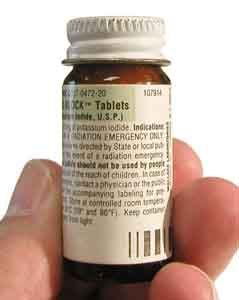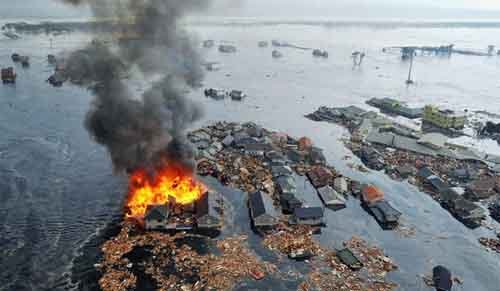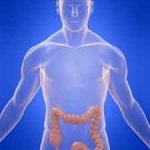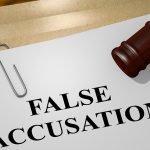Certainly, everyone now knows about the major earthquake and tsunami that struck Japan last week. And certainly, everyone who has been following this great human tragedy is also aware that three nuclear power stations are at risk. After that, however, accurate information is spottier, and speculation is far, far higher. Words such as meltdown and partial meltdown and containment are being bandied about with little understanding of what they actually mean. And far too many people outside of Japan are panicking with little justification for panic…yet.
Let me quickly explain over the next few minutes:
- What we know is happening.
- What might happen in the near future.
- What the potential dangers are.
- What precautions you might want to take — for yourself and your children.
China syndrome — not really
Several decades ago, it was hypothesized that in an extreme nuclear reactor accident, the reactor’s core could get so hot that it might possibly melt down, burn through the containment barriers beneath it, and then continue to flow downwards through the floor of the containment building — ultimately melting all the way through the crust of the earth and popping out on the other side in China. Thus, the name: “China syndrome.”
In truth, this scenario is likely as fictional as the movie based on the name. Since the surrounding ground beneath the reactor would absorb most of the heat during a meltdown — transferring the heat ever outward to the surrounding ground. For that reason, it is likely that the uranium core of a nuclear reactor would not melt down into the earth more than about 90-100 feet (about 30 meters), which is a bit short of the 8,000 miles needed to realize the China syndrome. So, the bottom line is that a meltdown by itself would be unlikely to pose a danger to the world at large — although it would be severely damaging to the area immediately surrounding the reactor for many, many years to come.
Into the atmosphere
 For the world at large, the danger comes when containment is broken, not downwards in a China syndrome type event, but rather in an upward direction from an explosion, which then releases substantial amounts of radioactivity high into the atmosphere by some subsequent event. For example, in the case of the Chernobyl reactor in 1986, the Number Four RBMK reactor went out of control during a test, which demolished the entire reactor building. It was a subsequent fire that then spewed large amounts of radiation high (a critical point) into the atmosphere. Once in the upper atmosphere, high winds and jet streams can carry the radioactivity all around the world, ultimately dropping radioactivity on everyone. But the reactors at Chernobyl were very, very different from the reactors in Japan. Unlike most reactors used in the developed world (including Japan), the Soviet Union RBMK reactors were built without a containment structure, the concrete and steel dome over the reactor designed to keep radiation inside the plant in the event of such an accident.
For the world at large, the danger comes when containment is broken, not downwards in a China syndrome type event, but rather in an upward direction from an explosion, which then releases substantial amounts of radioactivity high into the atmosphere by some subsequent event. For example, in the case of the Chernobyl reactor in 1986, the Number Four RBMK reactor went out of control during a test, which demolished the entire reactor building. It was a subsequent fire that then spewed large amounts of radiation high (a critical point) into the atmosphere. Once in the upper atmosphere, high winds and jet streams can carry the radioactivity all around the world, ultimately dropping radioactivity on everyone. But the reactors at Chernobyl were very, very different from the reactors in Japan. Unlike most reactors used in the developed world (including Japan), the Soviet Union RBMK reactors were built without a containment structure, the concrete and steel dome over the reactor designed to keep radiation inside the plant in the event of such an accident.
The bottom line is that even if there is a meltdown in one of the Japanese reactors, it is unlikely to breach containment in an upward direction. In fact, there has already been an explosion in one of the reactors with no breach of containment. (Understand, containment structures in nuclear reactors are really, really strong. In the United States, for example, they must be strong enough to withstand the impact of a fully loaded passenger airliner without rupture — for obvious reasons.) And if there is any breach of containment, it is likely to be small in scope and unlikely to reach the upper atmosphere, in which case, damage would be localized, not global.
That said, it is important to recognize that “unlikely” does not mean “impossible.” In other words, there is some degree of risk, no matter how small, that substantial amounts of radiation may leak from one or more of the Japanese reactors, make its way into the upper atmosphere, and ultimately drop down on the United States and the rest of the world. The amount of exposure to citizens outside of Japan would ultimately be small; but unfortunately, in the case of some types of radiation, small amounts of exposure can have significant health consequences — particularly for the vulnerable. The particularly nasty forms of radiation that we’re talking about include plutonium, iodine-131 and 134, strontium-90, and cesium-137.
Given exposure to radioactive fallout, you will want to focus on three things:
- Protecting your thyroid, the most vulnerable organ in your body
- Removing as much of the radiation as possible from your body, as quickly as possible
- Protecting your DNA from genetic mutation
Let’s now talk about how we do this.
Iodine
As mentioned above, radioactive iodine-131 is one of the elements likely to be released into the upper atmosphere after a nuclear event. Carried great distances on high speed winds, it can then drop down into the lower atmosphere, where it may be breathed into the lungs. It can also contaminate crops on the ground and get into the body through food and drink. (Fruits and wines are particularly susceptible.) The problem is that your thyroid gland has a tremendous affinity for iodine, radioactive or otherwise. In other words, the thyroid gland quickly absorbs radioactive iodine, where it can injure or even kill the gland. In fact, radioactive iodine is often administered by doctors specifically to kill the thyroid as a treatment in some thyroid diseases such as Grave’s disease.
If, on the other hand, you want to protect your thyroid from exposure to radioactive iodine as might be experienced through fallout, taking non-radioactive iodine just before (or immediately after) exposure will block radioactive iodine from being taken into the thyroid gland. It will thus protect this gland from injury. However, it is important to note that it will not prevent radioactive iodine, or any other form of radiation for that matter, from entering your body. It will not repair damage to the thyroid; nor will it remove the radioactive iodine once it has entered your body. Taking non-radioactive iodine before exposure will merely “pre-fill” your thyroid with iodine so that there is no room for the radioactive iodine to be taken up by your thyroid; thus the need to take the non-radioactive iodine before or immediately after exposure. Likewise, if radioactive iodine is not present or imminent, taking prophylactic non-radioactive iodine offers no protection, not to mention some risk from reactions to the high levels of supplemental iodine.
Ideally, the best time to take supplemental iodine is an hour or so before exposure, or immediately upon exposure, for maximum protection. Take it too soon in advance, and it will begin to clear the thyroid before the radioactive iodine enters the body, thus diminishing its effectiveness. (Iodine pretty much clears the thyroid in about 24 hours.) Take it too late, and the radioactive iodine will have already been taken up by the thyroid, in which case there will be little benefit. One thing to keep in mind is that a good liquid form of iodine, such as is available at most health stores will be taken up by your body almost immediately after ingestion, thus allowing you to wait until the last possible second.
 Note: you don’t have to jump the gun. Public health officials will advise you when you need to take supplemental iodine as protection. (Yes, I understand, they may prevaricate about the events leading up to a nuclear event. But once the event has happened and the radiation has escaped into the atmosphere, it will be impossible to hide. You will be told.) The trick is to make sure you have a supply of iodine on hand when you need it. Public health officials are prepared to provide everyone supplies of potassium iodide after a localized incident in areas surrounding a single nuclear plant, for example. But they certainly do not have enough iodine on hand to cover broad areas of a country to protect from exposure settling down from the upper atmosphere. Unfortunately, if you wait until the last minute, stores are likely to be sold out in a spree of panic buying — as we are seeing now. Just keep an emergency supply on hand for you and your family, and you’ll be fine.
Note: you don’t have to jump the gun. Public health officials will advise you when you need to take supplemental iodine as protection. (Yes, I understand, they may prevaricate about the events leading up to a nuclear event. But once the event has happened and the radiation has escaped into the atmosphere, it will be impossible to hide. You will be told.) The trick is to make sure you have a supply of iodine on hand when you need it. Public health officials are prepared to provide everyone supplies of potassium iodide after a localized incident in areas surrounding a single nuclear plant, for example. But they certainly do not have enough iodine on hand to cover broad areas of a country to protect from exposure settling down from the upper atmosphere. Unfortunately, if you wait until the last minute, stores are likely to be sold out in a spree of panic buying — as we are seeing now. Just keep an emergency supply on hand for you and your family, and you’ll be fine.
The standard form of iodine used in nuclear power plants to protect workers against radiation exposure in case of a leak is potassium iodide (also called KI). It is a salt of iodine that has the virtue of being stable. It will also be the kind you hear recommended most often on television since newscasters get their marching orders from the medical community and governments. But potassium iodide is not the only form of stable iodine. In fact, all food grade sources (and extracts from those sources) such as kelp are equally stable and may be used instead. You just have to make sure you use enough.
How much iodine should I take?
According to the FDA, the following doses are appropriate to take after internal contamination with (or likely internal contamination with) radioactive iodine:
- Adults up through age 40 should take 130 mg. (Note: this is about 700 times the normal daily recommended dose of 150 mcg. Also note that most iodine supplements sold in health food stores are sold in microgram doses, not the milligrams you need for thryroid blockage.) People over the age of 40 should only take supplemental iodine if they are exposed to a large dose of radiation. Older adults are the least likely to develop thyroid cancer and the most likely to have allergic reactions to the iodine. Obviously, the older you are, the less you should think about taking prophylactic doses of iodine.
- Women who are breastfeeding should take 130 mg. Pregnant women should take only one dose. And, I hate to say this, but nursing mothers should probably stop breastfeeding if they are exposed and use formula if available. If formula is not available, continue breastfeeding.
- Children between the ages of 3 and 18 should take 65 mg. Children who weigh 150 lbs or more should take 130 mg, regardless of their age.
- Infants and toddlers between the ages of 1 month and 3 years (either nursing or non-nursing) should take 32 mg.
- Newborns from birth to 1 month (both nursing and non-nursing) should be given 16 mg. Note: newborns less than 1 month old who receive more than one dose of KI are at particular risk for developing hypothyroidism. If not treated, hypothyroidism can cause brain damage. Infants who receive supplemental iodine should have their thyroid hormone levels checked and monitored by a doctor. Avoid repeat dosing.
Note: The thyroid glands of a fetus and of an infant are most at risk of injury from radioactive iodine. Young children and people with low stores of iodine in their thyroid are also at risk of thyroid injury.
A single dose of KI protects the thyroid gland for 24 hours. A one-time dose at the levels recommended above is usually all that is needed to protect the thyroid gland. In some cases, radioactive iodine might be in the environment for more than 24 hours. If that happens, local emergency management or public health officials may tell you to take one dose of KI every 24 hours for a few days. You should do this only on the advice of emergency management officials, public health officials, or your doctor. Avoid repeat dosing with KI for pregnant and breastfeeding women and newborn infants. For those individuals, evacuation may be the best alternative until levels of radioactive iodine fall.
Taking a higher dose of iodine, or taking iodine more often than recommended, does not offer more protection and can cause severe illness or death.
Also do not take iodine:
- If you are already taking medication with high levels of iodine.
- You are allergic to iodine.
- If you have a thyroid disease that is iodine sensitive such as Grave’s disease, do not take supplemental iodine without your doctor’s permission and guidance.
And finally, if panic buying has cleaned your local store’s shelves of iodine tablets, there is an alternative. Most people probably went to the “iodine” section of their health food store. There’s a good chance they didn’t check out the herbal extract section. You may find an iodine extract there that might have been ignored because the dosage “seems” low at first glance. I particularly like the Tincture of Iodine with Kelp from Vitality Works. The dosage seems low since it’s listed by the drop, but each bottle contains about 195 mg of iodine, making it easy to divide as necessary to get the appropriate dose. Uptake by the body is really quick. In most cases, two-thirds of a bottle will provide 130 mg. That means 2-3 bottles will cover most families.
Is there anything else you should do?
Absolutely!
Iodine only protects the thyroid, and only protects against radioactive iodine (iodine-131 and iodine-134). It doesn’t offer any protection against plutonium, cesium-137, and strontium-90, which are also likely to be present. It doesn’t clear radioactive matter from your body. It doesn’t protect against damage to your genetic material. If worst comes to worst, then I recommend a three-pronged approach.
 Use supplemental prophylactic iodine as described above.
Use supplemental prophylactic iodine as described above.- Use a good colon detox formula that contains substantial amounts of apple pectin and montmorillonite clay. As I’ve said for years, apple pectin actually draws radioactive waste from your body and passes it out through your colon. It’s one of the reasons I include it in my Colon Detox formula — to remove everyday contamination. This is not wishful alternative health thinking. Apple pectin was used in the aftermath of Chernobyl to reduce the load of radioactive cesium in children. Montmorillonite clay also has a strong affinity for radioactive matter.
- Use a supplement such as a good antioxidant formula or blood cleansing formula that contains chaparral extract. The primary biochemical in chaparral, NDGA (nordihydroguaiaretic acid), has been shown to protect the body against genetic damage caused by exposure to radioactivity.
- (Addendum — added 3/17) Keep in mind that plutonium, cesium, and strontium are all metals and so, to some degree, can be chelated from the body. Look for a heavy metal detox formula that contains both chlorella and cilantro.
Again, remember!
- We do not have an emergency situation yet.
- You don’t want to take prophylactic iodine prematurely since it clears out of the thyroid in 24 hours.
- Overdosing on iodine is a distinct possibility if you get carried away. Don’t get carried away.
The bottom line is that there is no need for panic. Outside of Japan, nothing has happened yet. Chill out. The odds of anything serious happening outside of Japan are very, very low. Your best bet is to make sure you have some iodine locked away for some future emergency. For further information, check out the related topic: Radiation Therapy, What Comes After?
For more information about radiation and Japan’s nuclear disaster, continue on and read Jon’s newsletter titled Radioactive Fallout Update!












Thank you Jon, this is very
Thank you Jon, this is very helpful.
OK – so what does one do if
OK – so what does one do if one is allergic to Iodine???
This is obviously a timely
This is obviously a timely article on Iodine and Radioactive fallout.
A regular supplementation of protein-bound iodine is always prudent to keep a healthy thyroid.
To maximize the recommendaitons of this article it will be wise to NOT drink fuoridated city water, do NOT brush teeth with fluoride toothpaste, do NOT drink any water that has chlorine in it (city water and unfiltered bottled water), do NOT eat bread-pastries etc. that have been made with bromide in it.
All of these deplete Iodine (see the “Periodic Table” for this) and will cause thyroid problems in general.
To check your iodine level use a iodine patch test.
You can ask for further advice about this from [email protected] and I will send you a paper about this test.
Kelp, dulce, watase and other marine vegetables should be a good start also.
This is a good article with
This is a good article with the exact information on nuclear fallout. Everyone should read it. Thank you Dr Barron.
I truly appreciate your
I truly appreciate your thoughts and ideas which you have freely shared. They are important to everyone’s wellbeing at this time. I have seen many emails come across with information, much of it misleading and tainted with fear, but their sole purpose was to capitalize on the situation and try to get us to purchase some ebook or report they were promoting. So I truly respect your work – your dedication to our health – – and your continued fairness. The Japanese people, and who knows what other communities across the globe, have quite the challenge ahead of them here and now is the time for all of us to band together as one world. I have followed your newsletter for quite some time, have never written to you, but I just wanted you to know how much your caring, proven dedication to humankind is valued. Thank you!!
A very interesting article,
A very interesting article, could the chernoble fallout be a contributing factor to the alarming number of people that suffer thyroid problems these days?
Incidently i had graves and had radioactive iodene treatment, I am now on thyroxine,how can i protect myself.
Good basic article but is
Good basic article but is inaccurate. All three plants have melted down and the explosion has breached the outer containment. Sailors on the Ronald Reagan Aircraft Carrier have tested with 30 times the normal daily environmental dose of radiation and they are 100 Miles out at sea from the explosion location. This is clearly more of an issue that is being alluded to above. The real issue is that Cesium-137 has a 30 year half life so the radioactivity will exist in the soil for a long time. It will affect plants and animals. The big question is “What impact will the fallout have on the USA, particularly those states in the west that will be first hit by the jetstream that is carrying the radioactive dust from Japan to the USA?”
To clarify on the USS Ronald
To clarify on the USS Ronald Reagan.
Tests detected the radioactivity on 17 U.S. Navy helicopter crew members when they returned to the USS Ronald Reagan after conducting disaster relief missions in Japan. The Navy said that no further contamination was detected after the crew members washed with soap and water.
The radiation that the crew members were exposed to was from a low hanging cloud of smoke and steam released from the crippled Fukushima Dai-Ichi power plant in an explosion. However, as stated in the newsletter, the containment dome in the reactor was not breached, and the cloud of steam and smoke did not even get close to the upper atmosphere so there is no danger of that cloud traveling to the US, or anywhere else in the world.
Again, for now, the reactor issues remain a localized problem in Japan — a very serious problem to be sure, but localized nonetheless. In other words, nothing in the USS Ronald Regan incident contradicts the essence of the newsletter.
And yes, cesium has a long half life. But that's one of the reasons I recommend doing two intestinal detoxes a year — to remove the contamination that your body is continually exposed to by all of the residual radioactivity that has been released into the atmosphere over the last fifty years.
Hope that helps.
Thank you for your update and
Thank you for your update and clarification. Great article Jon. We here on the West Coast are keeping a a watchful eye on what is occuring in Japan.
Can you give detailed
Can you give detailed information on the effects and dosage for people who have hypothyroidism already and take armour thyroid supplements. Thanks
Very interesting and timely
Very interesting and timely article. A couple of decades ago, I read a book about the benefits of miso. Apparently, according to the author, miso soup and various other fermented soybean products were claimed by a prominent Japanese doctor to have been instrumental in saving so many lives and minimizing radiation sickness in Hiroshima and Nagasaki after the A-bombs destroyed these cities in WWII.
Thank you Jon for a voice of
Thank you Jon for a voice of calm, with valuable information we can take in and utilize if needed. I totally trust information when it’s not based on fear and panic. Keep up the good work!
Here in Los Angeles people
Here in Los Angeles people are concerned and we cannot buy potassium iodide. The tincture of Iodine from Vitality Work is not readily available.
Kelp is/was available in 150 and 225 mcg. At one major health food chain 30 to 50 tablets a day was suggested while others suggested 2 to 3 tablets daily. In the worst case scenario how much kelp would be recommended?
I understand you cannot “prescribe” what to take but some guidelines would be appreciated.
thanks very much
Sorry, Brian. Those pills
Sorry, Brian. Those pills won't help very much. The math is simple.
There are 1,000 micrograms in each milligram.
Your kelp tablets contain, on the high end, 225 micrograms of iodine per tablet.
That means it takes four tablets to get 1 milligram of iodine.
But since you need a dose of 130 mg, that means you would need 520 tablets (4 x 130) to get your 130 mg of iodine.
For now, then, let's hope the radiation problem stays localized in Japan.
How much kelp granuales would
How much kelp granuales would I have to take? How much for a 4 year old?
Whats a good good colon detox formula?
Thanks
As for Kelp, see my comments
As for Kelp, see my comments to Brian below. As for dosage for a 4 year old, the article details dosages for all age groups above. The dosage recommendations, incidentally, come from the CDC and the FDA.
And as for a good colon detox formula, what can I say. I'm definitely partial to my own colon detox formula, which is available from http://www.baselinenutritionals.com.
At birth I had a hemangioma
At birth I had a hemangioma on my neck. They treatment in 1953 was to tape some form of radiation on my neck. My mother had to be covered while she held me. They wanted to do 12 treatments; however, after the first treatment my mother was very concerned and I never had another treatment (hemangioma disappeared on it’s own). Now at 57 I have an extreme cough and tyroid levels are not bad but are off some and my neck swells sometimes leaving it hard to breathe. I have had many test run and they find nothing. Is there any advice that you might have concerning this type radiation and the effects? Thank you.
What if your thyroid has been
What if your thyroid has been removed?? I would think you do not need the iodine?
Iodine-131 has a half-life of
Iodine-131 has a half-life of eight days and is quite dangerous to human health. If absorbed through breathing or contaminated foods, especially dairy products, it will accumulate in the thyroid and cause cancer. If your thyroid has been removed, then accumulation of Iodine-131 in the thyroid is not an issue and thyroid cancer is obviously not a risk.
We want to stop this insanity
We want to stop this insanity we, the people impose upon ourselves. We know how, now we need your help to do so. Are you ready for a true change that will be void of daily fear for your health and your lives? Let us know at http://harmonians.ning.com/?xgi=0RUnbbQxNy9zIn
Stan
P.S.
I have the highest regards and respect for Dr. Barron and his work. He was the only doctor out of hundreds who was able to cure our 18 month old daughter from atopic eczema. She will be 11 years old this year with smooth unblemished skin of a young beautiful lady. Thank you again Jon and Kristen.
Hi,
What was the cure. I have
Hi,
What was the cure. I have excema!
Thank you,
Barbara
Hi,
I am on 125 eutirox to
Hi,
I am on 125 eutirox to treat hyputhyrode.
I am 42, what is the recomendation?
Thank so much Jon.
Ana
For advice concerning
For advice concerning specific medications, you need to talk to your doctor. But as the article stated, the risk from radioactive iodine drop significantly once you pass 40. However, you would still want to consider detoxing radioactivity out of your body if exposed and protecting your cells from genetic damage.
I can not find vitality works
I can not find vitality works brand iodine with kelp in any google search.
Do you have a source for where to purchase these tinctures?
Not sure what is happening to
Not sure what is happening to my comments.
Sorry if this is a duplicate.
I can not find Vitality Works brand iodine with kelp.
I am google searching to no avail.
Jon, do you have a source where we can purchase these tinctures?
Thanks!
The largest ape with the
The largest ape with the largest brain and the highest distruction cababillity from any mammel ever will not stop before it is too late.
Way to many humens walk the earth (mor than double what earth can take) ea. mammel slows breading down or stops alltogehther when the surounding is overpopulated, not the humens.
To reverse the events for distruction is over, climatchange, foodshortage, drinkingwatershortage, resource shortage, of all kinds will dominate the next decades and not to forget the shrinking big rivers around the world, the melting claciers around the world will lift the oceanlevels that all the coastcitys go under.
The old Indian Chiefs where right with the predictions, the humans (pref. the white race) will not stop ……..
Mr Klaus,
Your statement
Mr Klaus,
Your statement makes little sense. How about proper spelling and grammar and then we could make sense of what you are trying to write!
Update.
According to
Update.
According to reports now coming out of Tokyo, officials say they detected 0.8 of a micro-sievert of radiation in the morning.
This is about 27 times what’s considered normal, and that is causing some panic in people writing into the Foundation. However, it is important to understand that a chest X-ray typically involves a dose of 20 micro-sieverts.
Bottom line: the damaged reactor is definitely discharging notable amounts of radiation into the air, but it is not yet blowing it into the upper atmosphere, and the problem is still localized to Japan at the moment.
I would have to agree with
I would have to agree with Casey above. I, too, appreciate the calm assessment. Right now, to me, you seem like the anchor in the storm. Something I think we all are sorely needing. It was a horrible thing that happened to those poor people and I really feel for them.
Thank you for all you have taught me throughout the years.
I have potassium IODATE,
I have potassium IODATE, rather than potassium IODIDE. Are the dosages the same. It says on the label to take it just one time 49 mg. I have been diagnosed with hypothyroidism and am in need of iodine and thyroxine. I have not taken any T3 or T4 supplements yet. Just ATOMIDINE. Will the IODATE supply my thyroid with the necessary iodine to prevent the radioactive iodine? Thanks so much. Amber
There are differences between
There are differences between P. Iodine (KI) and P. Iodate (KIO3). Both forms are often supplied by governments when exposure to radioactivity happens. Both will help prevent radioactive iodine from affecting the thyroid, however neither is a panacea.
More on this here: http://www.garmaonhealth.com/2011/03/do-this-japan-nuclear/
My N.D. recommends the use of
My N.D. recommends the use of Spirulina — apparently it was used at Cherynobyl (sp??) with excellent results. And certainly, it cannot hurt anyone, as it is a food.
Hi John,
I'm over here on
Hi John,
I’m over here on Oahu and it seems that all of the stores have run out of Potassium Iodide and Iodine in general. Any suggestions on where one might find a supplier?
Thanks!
Hi, and thanks for this
Hi, and thanks for this timely report. I’m sure me as well as everyone else is most worried about their kids–can you address specifically supplements that are safe for toddlers (in my specific case) in the event of radioactive fallout. Are your colon detox and blood/antioxidants safe for 2 year olds? What’s the best thing for our kids as far as supplements beside the iodide if it becomes necessary? Thank you.
I disagree with your fear of
I disagree with your fear of taking higher dose iodine/iodide on a daily basis. Dr. Abrahamson, Dr. Brownstein, Dr. Jonathan V Wright, Dr. Gaby all have written or spoken in seminars about the safe usage of high dose iodine.
Hi and thanks for your
Hi and thanks for your comment. I will search Joanthan Wright and the other sources you mention for the type and amount of high dose they recommendI in the meantime do you happen to know protocol for cats- or reference site I can go to?
Thanks!
In reference to Jon's
In reference to Jon's comments about the disaster still being localized, I don't know that there is any way to definitively confirm that Jon. I imagine that we don't not get a clear representation from the american media…David Wolfe reports in an email that on his return from Seoul South Korea, that the severity of the issue is all over Seoul TV and that it's "probably the worst disaster in history". So there's both ends of the spectrum in information….it may not be localized, we cannot irrefuteably know that at this point. (unless you have a source in Japan who is seeing it firsthand). Thanks for all the information.
headless chickens comes to
headless chickens comes to mind, good advice Jon but there is an awful lot of unnecessary panic going on in my opinion, there is plenty of natural radiation all around, you can get a decent dose just by living in some places
Wish I read this earlier
Wish I read this earlier today, instead of read some blogs on the internet and watched the news on tv. Would of saved me from a lot of stress and anxiety. Thank you so much Mr. Barron for your very informative and factual article. I truly appreciate it.
My heart, prayers and well wishes go out to everyone in Japan. May they find a way to finally contain and stop the awful problems they’re faced with right now at the nuclear plant, and overcome all of this as soon as possible. Positive thoughts….
Nothing to worry! We are
Nothing to worry! We are exposed to radioactive rays & radioactive fallout every moment on our planet and are becoming victim of radioactivity by using mobiles, TV, X-rays, etc; if somebody is found affected, there is treatment in Homoeopathy using latest researched medicines like “radioactive fallout”, “radioactive iodine” “radioactive uranium”, etc; and like!
The elevated spent fuel pools
The elevated spent fuel pools have also been compromised by the explosions.
Israeli dependents and non-essential embassy staff removed several days ago.
OMG. If it blows up … how
OMG. If it blows up … how much of the radiation will reach California??!!! I'm soo scared!
I happen to have Iodine
I happen to have Iodine Tincture in my medicine cabinet. It indicates that it is a First Aid Antiseptic for External Use only; mild USP; 47% alcohol. The bottle contains 1 Fl.Oz. Can this be “converted” to be used internally in case of radiation?
No, do not ingest this!
No, do not ingest this! Apply to skin only! Your skin will absorb and will go to Thyroid.
No. Topical iodine cannot be
No. Topical iodine cannot be ingested. You can put it on a maxipad or tampon and rub it on your breasts or testes. You can also mix it with shaving cream as topical use. Female parts and the male testes are most susceptible to the radioactive iodine 131.
I found out that no, you dont
I found out that no, you dont want to take topical iodine internally, it wont work in the way you need it to.
What if I am taking
What if I am taking medication on Levorthyroxine 100mcg. Should I take Iodine too?
lol I was about to take a
lol I was about to take a sail trip on the pacific right off BC..probably not the best idea now :p
I read that some companies
I read that some companies are promoting potassium iodate but it is not the same as potassium iodide and should not be used. Kelp and wheat grass juice together are a good combination. Kelp contains iodine and the chlorophyll in wheat grass juice also contains iodine. Nascent iodine is a very safe form of iodine and easily absorbed by the thyroid gland. It should still available online somewhere. It can also be used to purify water and is good to have on hand for emergencies. Someone mentioned spirulina which probably has iodine in, just like the wheatgrass juice but I haven’t read up on it. Fruits (such as apples and pears have pectin and I am going to keep some around to give my grand kids. Hope this helps.
I have not been using the
I have not been using the Main-Stream Corporate (News?) as my source of news because the corporate controlled (news?) is generally very unreliable…at least here in the United States anyway. I use Pacifica Radio specifically KPFK 90.7 FM here in Los Angeles, California as my main source for news. It is a fully publicly funded news source without ANY corrupt or corrupted so-called news…i.e. propaganda from corporate America or any of its allies in the greedy Capitalist system. There has already been very good information coming out on Pacifica Radio about what’s going on in Japan with regards to the nuclear problems. As any sane human being would know, nuclear power as a source of energy is NOT a “Clean” source of energy in any way, shape or form. And it is the long term problems that arise IF a nuclear power station actually survives it’s intended life span without incident. No, nuclear power is not an issue for the “answer” to our world’s energy needs, but more a political tool used by greedy executives in the IAEA’s agenda to proliferate more vacation homes and private residences for their families while filling their purses to overflowing with mula. Nuclear power = Insanity!
I would like the source to
I would like the source to purchase vitality works brand iodine with kelp. Thanks. And thanks for the sane article. Very needed and wanted. Jerr
What if I take bioidentical
What if I take bioidentical T3/T4 for hypothyroidism? Do I just have to remain unprotected from radioactive iodine and risk getting cancer? I have seen no information on what people on thyroid hormone should do. “Not take iodine” isn’t an answer. We don’t want to get cancer, either! I am under 40. Would stopping my meds for a day and taking iodine instead be OK?
Thanks
I was given radioactive
I was given radioactive iodine as a child for hyperthyroidism. I had become allergic to the neomercazole that I was given. Later I had a partial thyroidectomy.and have been on thyroid supplements since. This was over 25 years ago. How can I protect myself now?
One thing that is smart to
One thing that is smart to do, if we get radiation in the states, is to only drink distilled water. Distilled water removes radioactive substances, just as it will remove the element iodine, it will also remove radioactive iodine. Most of the children who died from cancer around Chernobyl was due to drinking contaminated water and milk.
I saw Vitality Works at
I saw Vitality Works at Wholefoods, but I think everyone is out of stock now. Other websites talk about eating seaweed, but you have to eat quite a bit to have any effect. Maybe all we can do is stay inside, and detox later.
Many people are deficient in
Many people are deficient in iodine. The thyroid gland takes up iodine when it can. With the Nuclear plants destroyed in Japan there is release into the air of radioactive isotopes 131 and 123. There has been a run on potassium iodine pills that are used to saturate the thyroid with iodine to prevent absorption. These are mostly sold out now. There is debate on the advisability of taking such very large doses beyond when it is clearly called for. Hopefully people here are monitoring air and rain levels and reporting this information in our news. In my opinion this is an appropriate time to spend a few weeks trying to get More than the RDA of iodine in our diets -instead of Less. I suggest a run on Tuna, Cod, Shrimp, Celtic Seasalt, Kelp powder, Nori, Kombu, Wakame and Arame at our favorite stores.
Please read this newsletter!
Please read this newsletter!
I have friends who keep
I have friends who keep asking me what they can do , they are both allergic to iodine , is there a safe alternative they can have on hand in case of unforeseen nuclear accident etc?
I am a flight attendant and
I am a flight attendant and am scheduled for 3 flights to Narita, Japan, each trip entails having a 24 hour layover in Narita. Narita is located 147 miles from the Fukushima Nuclear Reactor. I am trying to find info on radiation levels in Narita, but have not found good information. I have no known thyroid conditions and am preparing for a cleanse including colon cleansing, raw foods and fresh vegetable juices. I take Waiora Natural Cellular Defense (suspended liquid zeolite)and plan in increasing my dosage to 10 drops 3 times daily. Would your recommend taking the 130mg of Tincture of Iodine (provided I can find it) upon landing NRT (Narita) each time? I am comfortable with the idea of continuing with your colon cleanse for the month, but wondering about the iodine. Thank you!
NOW how do you feel? With
NOW how do you feel? With radiation in our food, in our drinking water, in our air and in our ocean and soil ?
Hi my loved one! I wish to
Hi my loved one! I wish to say that this post is amazing, nice written and come with approximately all significant infos. I would like to peer more posts like this .